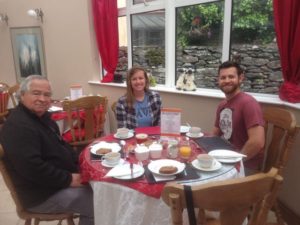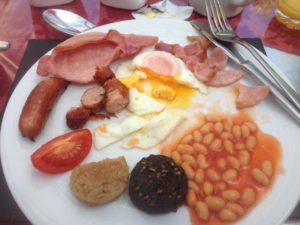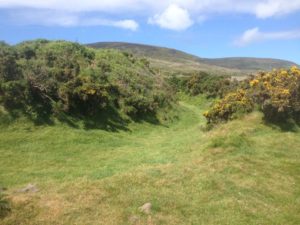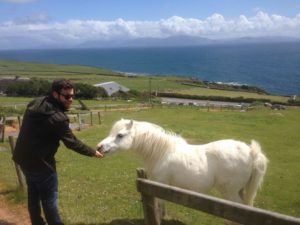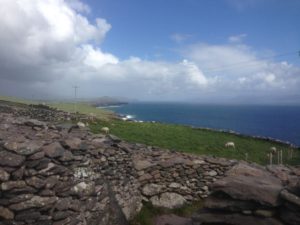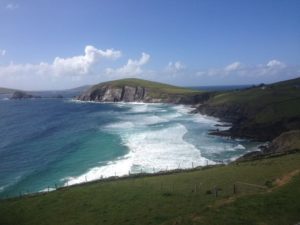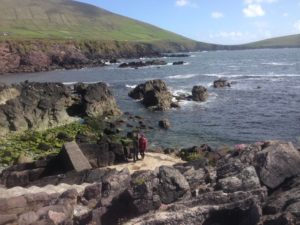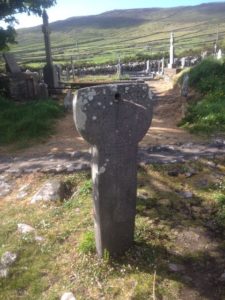After an amazing full Irish breakfast with sausage, bacon (ham), black and white pudding, beans, egg, tomato, and fantastic home made Irish bread, we set out for the Connor Pass, ten minutes outside of Dingle.
The pass is 410 meters high with stunning views of both Dingle Bay and Brandon Bay.
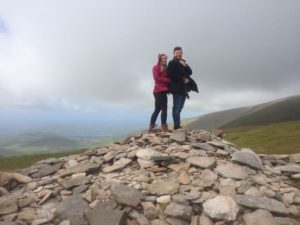 The fog swept over the pass with alarming speed, falling into the valley like a waterfall. The yellow gorse and pink foxgloves are in bloom. Both valleys are a patchwork of green fields partitioned by stone fences. We chose to go no farther than the car park because the pass is a one lane road.
The fog swept over the pass with alarming speed, falling into the valley like a waterfall. The yellow gorse and pink foxgloves are in bloom. Both valleys are a patchwork of green fields partitioned by stone fences. We chose to go no farther than the car park because the pass is a one lane road.
Slea Head Drive is supposed to take a half day, but we spent the entire day and wanted more time to take short hikes along the coast. If you only have one day in Dingle, Slea Head is the thing to do. We walked down to the beach in Ventry, stopped at the Celtic Prehistoric museum (private 5 E, but well worth it for the stunning collection of prehistoric pieces, including he largest wooly mammoth skull in the world, and neolithic and bronze age pieces that rival any museum. There is also a shop that sells local art (wool scarves and caps, carved fairy heads, and items from norther Thailand, where the proprietor spends the winter).
Next we stopped at the Lios (2 euro), a fairy fort, built by pre Celtic inhabitants known as Tuatha Dé Danann. It is a ring fort with earth berms crating a moat surrounding the what would have been dwellings. (Also a chance to feed the sheep and thick-furred Irish donkeys).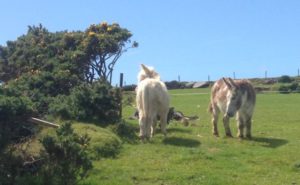
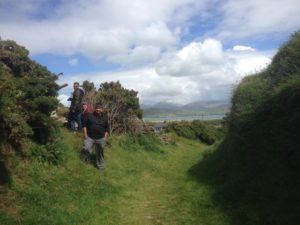
Then it was on to Dunbeg Fort (3E), inhabited since 900 BC but used primarily in eight and ninth centuries.
It has a series of four earthen berms and an inner drystone wall, which has a stepped structure on the interior that might have accommodated seating for some sort of ceremony. Inside is a large stone Beehive structure that is believed to have had a thatched roof. A storm in 2014 washed away part of the wall and the fort’s days seem numbered.
From Dunbeg Fort we walked to the famine houses (2E), with more food for sheep, ponies, and a llama.
The story of the potato famine is a horrendous one. When the potato crop was killed in 1845 and 46 by a blight apparently imported from US, thousands of poor Irish farmers died of starvation, leading to massive emigration to the US and Canada on boats that were so overcrowded they were called coffin ships.
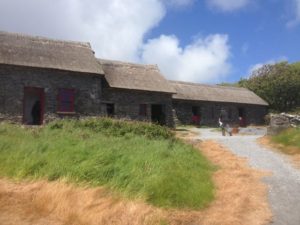 Many contracted fever and died in route or once they reached their destination. Gross Isle, outside of Quebec, was a quarantine island for new immigrants, with many forced to remain on the ships they arrived on, with both healthy and sick people confined in overcrowded conditions that spread the disease.
Many contracted fever and died in route or once they reached their destination. Gross Isle, outside of Quebec, was a quarantine island for new immigrants, with many forced to remain on the ships they arrived on, with both healthy and sick people confined in overcrowded conditions that spread the disease.
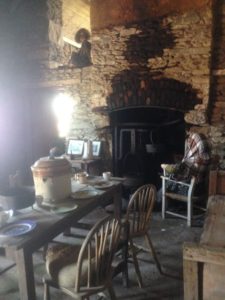 After the famine houses, we decided to eat lunch at the Storehouse Restaurant where we parked because of the gorgeous view.
After the famine houses, we decided to eat lunch at the Storehouse Restaurant where we parked because of the gorgeous view.  It started to sprinkle after we ordered and we moved inside and enjoyed a lovely meal minus the view. Kaylea has been impressed by how everyplace we have been has had a gluten free menu.
It started to sprinkle after we ordered and we moved inside and enjoyed a lovely meal minus the view. Kaylea has been impressed by how everyplace we have been has had a gluten free menu.
Next, we stopped at the Beehive huts, inhabited between 2000 BC and 1200 AD.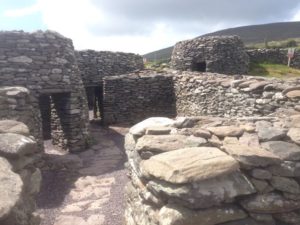
I had read about two great short walks, one from the Blasket Island Center carpark, which was easy enough to find. We skipped the center and opted to walk right from the carpark for ten minutes to the coast and then another five minutes around the headland and were rewarded with unbelievable views from what must have been a landing spot for boats going to the Blasket Islands because we found cement stairs leading down to the crashing sure, quite dramatic.
The second hike was from the car park for Clogher Head Beach, but by then it was after five and we had ticket for a 7:30 concert in St. James church, so we decided to skip that walk and head back to Dingle via N-560 just past the Gallarus Oratory (3E), a drystone built rectangular building that looks much like an upturned boat.
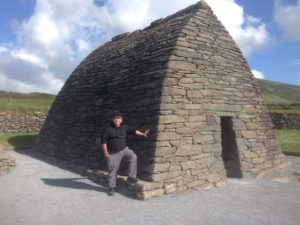 We took R559 back toward Dingle, and our last stop was Kilmalkader Church, a roofless Romanesque ruin with a ogam stone that is said to have the Roman alphabet inscribed on its side.
We took R559 back toward Dingle, and our last stop was Kilmalkader Church, a roofless Romanesque ruin with a ogam stone that is said to have the Roman alphabet inscribed on its side.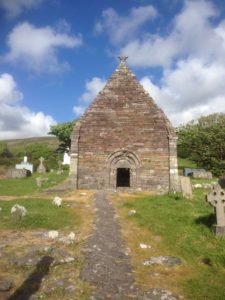
In the graveyard, there is also an ancient sundial and a second inscribed stone.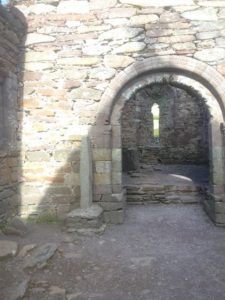
We got back to our B&B in time for a short rest before we headed out to a 7:30 folk concert at St James Church on Main Street, a regular even on Wednesdays, We heard a wonderful evening of music with fiddle, Irish pipes (a modified and much better sounding bagpipe).
When that ended, we wandered next door to the Dingle Pub for more trad music and hoping for some food, but as we discovered, kitchens all over town shut down at 9 pm. We wandered down to Dick Macks, a traditional pub with lots of tiny rooms, and ended up at John Benny’s where we heard a female group with lovely vocals and enjoyed Guinness for dinner.




